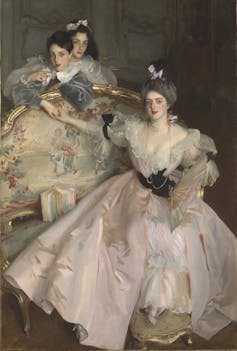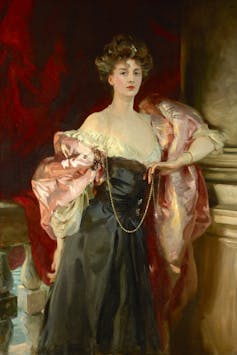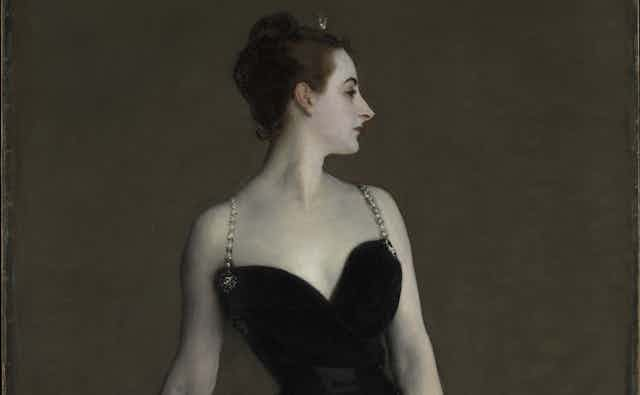Another exhibition celebrating male artistic genius through depictions of elite women may sound rather dull, but the Tate Britain’s new exhibition on John Singer Sargent is a refreshing look at this master’s skill of painting fashion.
As a fashion historian, whenever I visit an art exhibition, I tend to leave with a camera full of photos of the sitters’ clothes, rather than their faces, anyway. I am often in awe at how masterfully the rich tones in swishing silks and the twinkling light in bejewelled details can be captured.
Among art critics, fashion in portraiture often receives prejudiced derision. Already, Sargent and Fashion has been described as “canvases … crowded by old clothes” and a “surfeit of sweetness”. Misguided and outdated notions that clothing is frivolous and unimportant are, unfortunately, still prevalent among art critics.
Yet this exhibition, collaboratively curated by the Tate and the Museum of Fine Arts, Boston, attempts to redress this antiquated and blinkered attitude. Sargent would not be Sargent if it was not for the way he handled fashion. This exhibition compels the visitor to consider that skill with a paintbrush also required skill with fabrics, needles and pins.
The importance of fashion was well established with the Victorian fashionistas that Sargent painted. They understood the intense image-making power that their clothing choices had.
Margaret Oliphant noted in 1878: “There is now a class who dress after pictures, and when they buy a gown ask, ‘Will it paint?’” Fashion and art were innately intertwined and fashion’s modernity, dynamism and cultural relevance is present in every brush stroke.
Sargent the fashion stylist
Stepping into the first room of the exhibition feels much like being welcomed into a salon by its hostess. A 1907 portrait of Aline de Rothschild, Lady Sassoon, greets visitors as they enter. Draped in a dramatic fantasy of crisp black taffeta, the sitter’s face glows out from the swirling darkness of her opera cloak. Even in my carefully chosen fashion historian chic, it managed to make me feel remarkably under dressed.

But perhaps my sense of personal sartorial drabness is because I need Sargent’s transformative skill as an artistic director to elevate my look. This exhibition frames Sargent not just as a painter, but as a stylist.
He wielded not only paintbrushes, but pins, to manipulate and engineer fabric into dizzying shapes around his subjects. The curators compare Sargent to an art director at a fashion shoot. His paintings do not meticulously record the fashions of the day, instead they are carefully constructed visions of his own aesthetic agenda.
The cloak Rothschild wears in her portrait is displayed close by. The cloak dates to 1895 and predates the portrait by a decade. It serves as another reminder that fashion in this context is not about constantly evolving trends. Even a ten-year-old cloak could by styled into a vibrant moment of modernity through Sargent’s pinning and draping.
Throughout the exhibition, the paintings are slotted back into the broader cultural landscape of the turn of the 20th century. Satirical drawings which lambasted the fashions, photographs of the sitters at work and play, and the garments and accessories Sargent depicted are peppered through the exhibition.
The women we don’t see
While Sargent’s work as an artist and stylist is present everywhere, the makers of the fashion items themselves (usually poorer women) remain relatively obscure.
Aside from a short panel on Charles Frederick Worth, whose importance within 19th-century fashion is often overemphasised, there is minimal acknowledgement of the hands which cut, pinned and stitched the glorious concoctions. The garments and accessories on show throughout the exhibition are often accompanied by the tag “maker unknown”.

The exception to this is the curators’ inclusion of Adele Meyer. Painted by Sargent in 1896, Meyer was both a stylish woman of fashion and a pioneer of garment workers’ rights.
Along with Clementina Black, Meyer authored Makers of our Clothes: A Case for Trade Boards, which was published in 1909. This volume was an investigation into working conditions in the dressmaking and tailoring trades.
The book is displayed next to the painting, but very much cast into the shadows when next to the glittering brilliance of the painting. Together, this display serves as a reminder of, rather than a resistance to, the ways in which garment makers’ labour is overshadowed by the beauty of fashion.
A gently feminist exhibition
The exhibition does gently push back against power structures in other areas. Traditionally, these paintings are known in art historical circles by their sitters’ married names.

Mary Louisa Cushing is known only as Mrs Edward Darley Boit and Mathilde Seligman as Mrs Leopold Hirsch. Following Victorian etiquette and sensibilities, these women lost their own names and were swallowed up into their husband’s identities.
Radically (although it shouldn’t be radical at all) the curators have twinned these official titles of the paintings with the sitter’s own maiden names. This is a subtle switch, which will go unnoticed by exhibition-goers unfamiliar with this convention. Yet it is an important normalisation of these women as individuals and not the property of their husbands.
Ultimately, this is an exhibition which subtly moves in the right direction. The opportunity to see the infamous Madam X, the socialite Virginie Amélie Avegno Gautreau, in her iconic and sexy black gown will no doubt be a major draw for visitors. Yet the exhibition does not say much new about fashion history. Instead, it is a gentle realisation that Sargent’s skill with fashion was fundamental to his success as an artist.

Looking for something good? Cut through the noise with a carefully curated selection of the latest releases, live events and exhibitions, straight to your inbox every fortnight, on Fridays. Sign up here.

